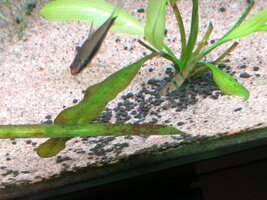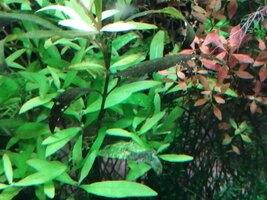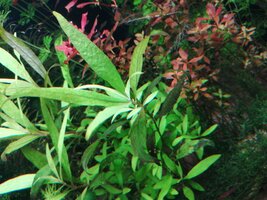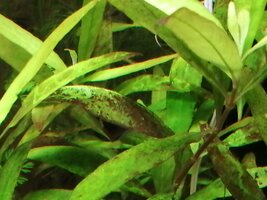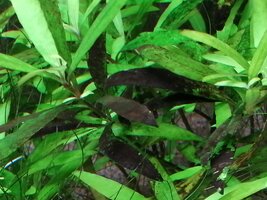Hi,
Due to my condition of being uninformed or uneducated I now got myself some kind of algae. It looks like this: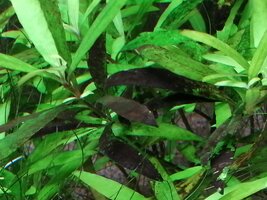
A while ago, In the "Lighting discussion", I sought advice regarding Chihiros WRGB II Pro light, which I acquired recently. Didnt know it is as strong as it turned out to be. I was too slow to adjust it to a level where I didnt ruin the plants. Had it going at the following positions: Red:105%, green 85%, blue 65% white 50%. Way too much intensity. Guess I have to learn the hard way. Since yesterday the light level is at a more reasonable level (I hope): Red:45%, green 40%, blue 45% white 45%. Maybe still too much? Since friday some plants looks like the one at the photo. They are covered in something black. Cant identify it propperly from any photo on the internet. Maybe you can help me out?
Can any identify what kind of algae the "black" on the plants is - and what to do to get rid of it? And while I was reading about algae, I often ran into the phrasing "Lean dosing method" What does that mean?
My reference looks like this:
• Juwel Rio 350 - well planted. Not heavy but not minor either
• Lighiting: Chihiros WRGB II Pro, Red:45%, green 40%, blue 45% white 45%, 8 hours a day, (sync with CO2)
• River Stone Modul K from Rock Zolid as filter, filled with Bioelements and two kinds of sponge with Oase OptiMax 800 powerhead
• The filter above will in a short while be replaced with: Juwel internal filter - 1000L/hr pump (Sponge (fine and coarse sponge), purigen, Eheim Substrate Pro) (top right towards top centre)
• Pressurized CO2, Drop checker is green
• Tunze 6020 powerhead turns on when CO2 is on for better circulation, and turns off when light is off for fish to rest.
• Dosing 6 ml of Tropica Specialised Nutrition on a daily basis .
• 12 five banded barb - They will soon leave
• 12 red phantom tetra
• 9 Siamese algae eater
• 9 Corydoras sterbai
• 4 Bolivian Ram
• 2 Apistogramma Macmasteri Red Mask - To arrive soon
• 12 Cardinal Tetra - To arrive soon - If the space is there
Due to my condition of being uninformed or uneducated I now got myself some kind of algae. It looks like this:

A while ago, In the "Lighting discussion", I sought advice regarding Chihiros WRGB II Pro light, which I acquired recently. Didnt know it is as strong as it turned out to be. I was too slow to adjust it to a level where I didnt ruin the plants. Had it going at the following positions: Red:105%, green 85%, blue 65% white 50%. Way too much intensity. Guess I have to learn the hard way. Since yesterday the light level is at a more reasonable level (I hope): Red:45%, green 40%, blue 45% white 45%. Maybe still too much? Since friday some plants looks like the one at the photo. They are covered in something black. Cant identify it propperly from any photo on the internet. Maybe you can help me out?
Can any identify what kind of algae the "black" on the plants is - and what to do to get rid of it? And while I was reading about algae, I often ran into the phrasing "Lean dosing method" What does that mean?
My reference looks like this:
• Juwel Rio 350 - well planted. Not heavy but not minor either
• Lighiting: Chihiros WRGB II Pro, Red:45%, green 40%, blue 45% white 45%, 8 hours a day, (sync with CO2)
• River Stone Modul K from Rock Zolid as filter, filled with Bioelements and two kinds of sponge with Oase OptiMax 800 powerhead
• The filter above will in a short while be replaced with: Juwel internal filter - 1000L/hr pump (Sponge (fine and coarse sponge), purigen, Eheim Substrate Pro) (top right towards top centre)
• Pressurized CO2, Drop checker is green
• Tunze 6020 powerhead turns on when CO2 is on for better circulation, and turns off when light is off for fish to rest.
• Dosing 6 ml of Tropica Specialised Nutrition on a daily basis .
• 12 five banded barb - They will soon leave
• 12 red phantom tetra
• 9 Siamese algae eater
• 9 Corydoras sterbai
• 4 Bolivian Ram
• 2 Apistogramma Macmasteri Red Mask - To arrive soon
• 12 Cardinal Tetra - To arrive soon - If the space is there


